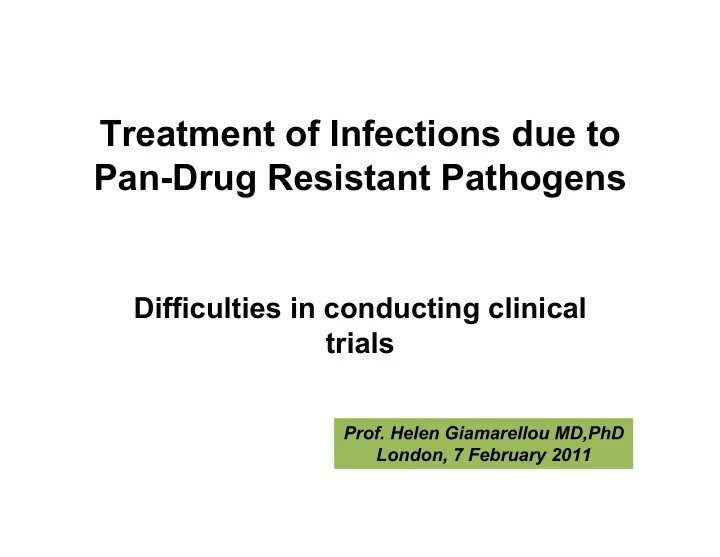

Treatment of Infections due to Pan-Drug Resistant Pathogens Difficulties in conducting clinical trials Prof. Helen Giamarellou MD,PhD London, 7 February 2011
The Greek View of the Appropriate Definitions Based on the Chaos of Resistance Mechanisms 1. “Pandrug Resistant (PDR): To all classes of antibiotics (in the Greek language the prefix “pan-” means “all” or “whole”) 1. Extensive Drug Resistant: To all classes of antibiotics except 1 or 2 (colistin-tygecycline) 2. Multidrug Resistant: Resistance to ≥ 3 major classes of antibiotics Falagas ME, Karageorgopoulos DE. CID 2008;46:1121
Dilemmas during the design of the clinical trial
Which setting or patient population? • Usually critically ill patients (in the ICUs) harbor such pathogens and develop infections due to them. • This is a patient population with many confounding factors when evaluating: - response, - mortality - drug toxicity
Which infections to focus to? • Various types of infections of varying severity. • Not big enough numbers of cases if aimed at a certain type of infection. Only in multicenter trials such studies could be conducted, however sharing the well-known drawbacks. • VAP which is common and popular is difficult to define. • Bacteremia (primary) is another choice.
Isolation of Pathogen(s) • Prompt and rapid identification of pathogens • Direct susceptibility testing is required. • Surveillance cultures
Target Antimicrobial Therapy CID 2007;44:382
Direct E-Test in 250 Episodes of VAP Outcome E-test group Control group P (n=83) (n=167) Fever, 4.61 ± 5.06 7.84 ± 6.24 <.01 mean days±SD Antibiotic therapy, 15.72 ± 9.47 18.92 ± 10.92 .02 mean days ±SD Clostridium difficille - 3 (1.8) 8 (9.6) <.01 associated diarrhea, no. of patients(%) Median no. of days on 8 (3-19) 12 (6-21) .04 mechanical ventilation from VAP diagnosis (IQR) Bouza E, et al CID 2007;44:382
Which antimicrobial drug to use? Mostly these pathogens are XDR, ie. sensitive to one (colistin) or 2 drugs (tigecycline, colistin or genta) Tigecycline: • Unresolved questions about effectiveness, especially in VAP and severe sepsis, as well as in case of bacteremia. • In the latter case, and when the approved dosage schedule of 50mg Q 12h is followed, the obtained peak levels in the blood are as a rule lower than the expected MIC of pathogens such as Acinetobacter baumannii and Klebsiella pneumoniae
Which antimicrobial drug to use? Monotherapy or combination therapy? • Colistin with no clear dosage regimen and lack of PK/PDs. • Colistin plus genta : Nephrotoxicity ? • Fosfomycin can not be used as monotherapy because of development of resistance.
Examples of PK/PDs PKs of Colistin in Critically ill Patients: a Greek Study How to Improve Therapeutic Results ? • Longer colistin half-life (14.4h) than previously described • Sub-therapeutic concentrations (0.6 μ g/ml) during the first days that may lead to: – Treatment failures – Emergence of resistance Dosage Regimen Reevaluation: Loading with 9 x 10 6 iu followed by 3 x 10 6 iu q8h ? Plachouras D et al. AAC 2009;53:3430
Serum Bactericidal Activity in humans of Three Different Dosing Regimens of Colistin with Impact on Optimum Clinical Use • All serum samples containing colistin > 4 μ g/ml (serum concentration/MIC: > 4) eliminated P. aeruginosa • Only 40% of samples containing colistin < 4 μ g/ml resulted in complete bacterial killing. Daikos GL, et al. J Chemother 2010;22:175
Problems in the design of the study • Can we reliably identify patients at risk of infections due to XDR pathogens? • In settings with low incidence of XDR bacteria this would result in initial overtreatment of a high number of patients rising questions about ecological damage. On the other hand, physicians do not like to change a successful therapy!
Problems in the design of the study • Impossible to have a control or a comparator treatment arm and to perform a randomized study because it is also unethical. • Treatment should start as initial empiric antimicrobial therapy [based on local resistance patterns and risk factors] and cases will be finally enrolled after documentation of infection and identification of the responsible pathogen and its sensitivity. • The “Golden hour” of therapy should be considered. • De-escalation should be obligatory.
International registry? Would a prospective international registry of these infections be able to provide some answers initially helping to collect more information in order to design more effectively a clinical trial?
An Example of Co-operation • Participants: Three tertiary hospitals located in Athens • Consecutive patients with K. pneumoniae BSIs • A total of 162 patients were included in the analysis – 95 VIM-negative: – 67 VIM-positive: 14 with MIC > 4 μ g/ml for both carbapenems and 53 with MICs ≤ 4 μ g/ml GL Daikos et al Antimicrob Agents Chemother 2009;53:1868
Mortality Rates According to Treatment Regimens GL Daikos et al. Antimicrob Agents Chemother 2009;53:1868 30 25 Mortality Rate % 20 15 10 5 0 2 Active One Active No Active Drugs Drug Drug MIC ≤ 4 μ g/ml MIC > 4 μ g/ml
Kaplan-Meier Survival Curves of 162 Patients with K. pneumoniae BSIs According to Susceptibilities to Imipenem p=0.03 GL Daikos et al . Antimicrob Agents Chemother 2009;53:1868
Which is the Correct Carbapenem Clinical Sensitivity Break Point for Klebsiella-pneumoniae VIM (+) or KPC (+) that Guides to the most Appropriate Therapeutic Decision ? From the Presented Preliminary Data it Seems that: An MIC ≤ 4 μ g/ml is predictive of combination of high-dose meropenem (2g every 6 or 8 hrs) with colistin (or with an aminoglycoside or with tigecycline). GL Daikos et al. Antimicrob Agents Chemother 2009;53:1868
An Example of a Multicenter Prospective Study or of a European Registry for Evaluation of Fosfomycin • Patients in the ICU with VAP and bacteremia. • Appropriate cultures are obtained. • The patient is given 2 or 3 antibiotics to cover any possibility of XDR (i.e fosfomycin plus meropenem plus colistin). • On the 3 rd day and according to culture results de-escalation to two antibiotics, i.e. fosfomycin plus colistin or meropenem.
Recommend
More recommend